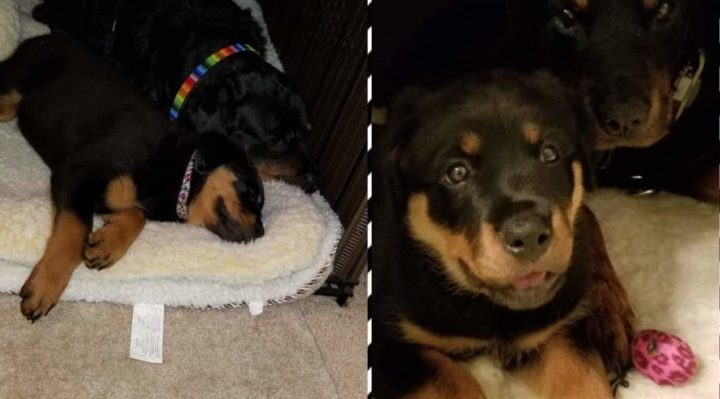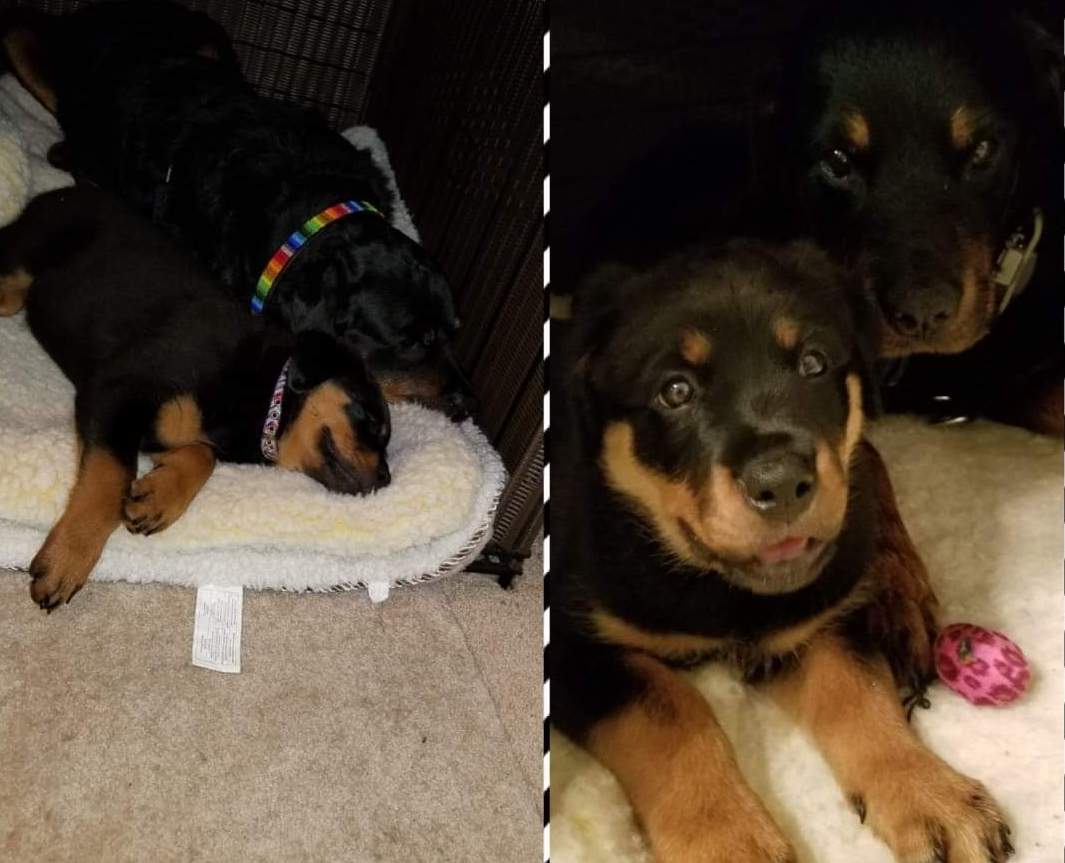
Dog professionals recommend that you start to pick a puppy with the most important part of the process: you choose that puppy’s breeder. I asked dog professionals to answer some questions about how they picked their puppy’s breeder. What qualifications were most important?
“When you picked the breeder of your puppy, what qualifications did the breeder have that were most important to you? What was the process to get a puppy? How long did you wait? Did the breeder pick your puppy for you or did you pick your puppy? When it was time for your puppy to come home to you, how did that work?” (I was especially interested in the details of long-distance transportation.)
Last week, I shared some of the answers—this week, more information.
Ski Tamborski (Colorado) When Ski had beaten his fourth cancer, I knew it was a sign. The healthiest Rotties I knew were owned by a trainer at Camp Dogwood. They were working dogs and looked amazingly fit. I contacted the owner and asked where she got them. Breeder wrote a long note identifying the handful of Rottie breeders in the U.S. that did everything right, and then mentioned that her own female was with child for the first time. The decision was easy for me. We had known each other casually for years, so we already trusted each other. I had watched her work her dogs and their relationship, and many mutual friends confirmed that I wouldn’t find a better breeder to work with.
During our discussions, it became clear that she performed more genetic and physical testing that I had seen before, and had a goal of producing puppies that improved the breed. I explained that I would be happy with an abnormally healthy pet-quality puppy. In fact, Ski was the runt of his litter, and I would be happy taking the runt again. Her puppy setup was ideal. She had a new toddler and socialized the puppies, and her adult Rotties were physically impressive, but also show intense interest in and love for humans. Checked all boxes.
I visited the puppies every single week, driving up to two hours each way in Chicago traffic, changing shoes and clothes when necessary to eliminate the possibility of parvo. I brought various toys, and items like our cat tunnel to expose them to new smells and sensations. Although the parents were IPO champions, the breeder knew that I wanted a general-purpose Rottie that I would train in a dozen different sports, but had no interest in bite sports. That gave us both an idea what to look for, and we discussed the puppies each week.
Ultimately, I fell for a shy girl that just cuddled with me. That puppy had a minor structural issue that the breeder said would limit her in sports and agility, and Siri began to steal my heart. We agreed that Siri was the best fit for my lifestyle. At the time, she was small and her sisters were ganging up on her. Eventually, she became 50 pounds larger than her smallest sister, and gained the self-confidence that she needed.
As we got to week eight and the first puppy was taken home, it was also time for Camp Dogwood. I left Siri with the breeder an extra week so that Camp Dogwood could be just about Ski. It was on the way, so we stopped at the breeder on the way to camp for a quick visit to see Siri. As I pulled up in front of the house towing my RV and with Ski, two cats, and a guinea pig in the car, smoke began to billow out from my engine. In a panic, I got the animals out of the car onto the lawn and realized there was no way to un-hook the RV quickly. As I watched the engine burn, I remembered that I carry a fire extinguisher in the RV. I had the fire out before the fire department got there. Amazingly, we made it to camp, though it ultimately took days to repair the damage.
A week later, I returned for the car repair and our new puppy. That same night, Ski had hydrotherapy at our vet, but was very weak from the cancer. We had to help him back to the car using a sling, and tears were shed. When we got home, Ski went into his crate, and Siri crawled in next to him. That puppy gave him a reason to live, he pushed cancer back a bit, and they had three wonderful months together.
Sorry, a little off-topic with puppy choosing!

Photo by Ski Tamborski
Timothy Page (Oregon) We got a call from a close friend in Salem. Her dog was having puppies and she offered one to us. Chiquis turned out to be the sweetest chihuahua ever. That was about 14 years ago. Sadly, we lost her to cancer a year ago. She was a flyball champion (in the top ten of flyball chihuahuas nationwide on NAFA) and had earned her Iron Dog title. Our friend bred her dog only twice before spaying her, so Chiquis was the only one for us. She was a treasure.
Ruth L. Heller DVM (Pennsylvania) My most recent Danes have come from breeders I was referred to and who were breeding to dogs coming from my own lines. I wanted to trace back to my lines. Way back—I spent months looking up pedigrees, show records, longevity, health records where available, visited and met parents.
Then I waited …
Months, in some cases.
Most of my puppies I have picked up at the breeder’s home. Stevie was delivered to me by a mutual friend who had helped with the litter. In all but one case, I expressed my preference to the breeder and have been lucky enough to get my pick. But Stevie was my second choice—she kept my first choice! I don’t regret it at all, and his brother ended up not showing well, so I got the better of the deal anyway.
Rebecca King (Ohio) Physical and behavioral health, and screening for genetic disease. Raised in an environment where the dam and litter are not stressed; referrals from three past owners and the vet; parents are confident, sound dogs with good breed conformation; current core vaccines on batch; ENS (early neurological stimulation) or Puppy Culture would be ideal.
Annie Zeck (Washington) My breeder was Performance Breeder of the Year with AKC a few years ago. It is important for me to have dogs that have drive, are smart, and are friendly. It doesn’t hurt that she is also my veterinarian.
Lynn Brezina (Illinois) The first thing you want to look for is how many litters they produce. The really good breeders only produce a litter every couple of years, but a couple of litters a year is okay. One cannot properly raise puppies when one produces too many. Get on the waiting lists of several breeders. Keep an open line of communication. See as many puppies as you can. COVID has reduced those opportunities, but always ask. Go meet breeders at local dog shows; there are many of those in most states. See what the National Clubs say about health issues. Then meet the parents or as many adult dogs as possible related to the puppies you are considering. Those dogs will be the best predictors of temperament, personality, stability.
Jean A. Roberts (California) And for those of us with “working” dogs … I always recommend that people see the parents/other relatives work. Or go to a trial, watch the dogs, see which ones you like, find out their pedigrees.
Kenna Stonefern (New Hampshire) I think the responses so far have to do with how to find a reputable breeder. I think that this is a given. The question for me is how did I choose my breeder from those who I considered to be reputable? The reality is that I would love any puppy that came into my life, but I wanted a breeder that I could rely on for assistance and who could answer questions for me over the long term. My breeder had to be a responsible breeder, of course—all health clearances, achievements in competition, appropriate care of puppies, etc., but also a person I could see myself having a relationship with over the next 15 years, I hope. That relationship was actually more important than the actual puppy when choosing amongst the host of reputable breeders out there.



